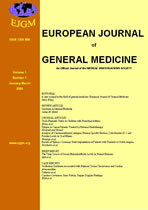
|
European Journal of General Medicine
Medical Investigations Society
ISSN: 1304-3897
Vol. 7, No. 2, 2010, pp. 174-178
|
 Bioline Code: gm10029
Bioline Code: gm10029
Full paper language: English
Document type: Research Article
Document available free of charge
|
|
|
European Journal of General Medicine, Vol. 7, No. 2, 2010, pp. 174-178
| tr |
İdrar yolu enfeksiyonu tanısında striple ve mikroskopik idrar analizinin performans özellikleri
Memişoğullar, Ramazan; Yüksel, Hatice; Yıldırım, Hayriye Ak & Yavuz, Özlem
Amaç: İdrar kültürü idrar yolu enfeksiyonunun saptanmasında referans test olarak kabul edilmekle beraber pahalı ve zaman gerektiren bir testtir. Çalışmamızın amacı, striple idrar analizi ve mikroskopik idrar analizini karşılaştırmak, strip ve mikrosopik idrar analizi sonuçları ile idrar kültür sonuçları arasındaki ilişkiyi bu testlerin performans özelliklerini ölçerek değerlendirmektir.
Metod: İkiyüzelli hastadan sabah idrar örneği alındı. Laboratuarımızda idrar analizleri yapılıp kültür için ekimleri yapıldı. Laboratuar idrar analizi Miditron-M Reflektans fotometresi ile otomatik strip okuma ve mikroskopik çalışmayı içeriyordu.
Bulgular:Hastaların %35.6 sı (89/250) idrar kültürleri 105 koloni/mL veya daha fazla organizma içeriyordu. Mikroskopik idrar analizinin sensitivite ve spesifitesi sırasıyla %91 ve %68, striple idrar analizinin %80 ve %60 idi. Negatif prediktör değer strip için %84, mikroskopik analiz için %93, pozitif prediktör değer strip ve mikroskopik analiz için sırasıyla %52 ve %61 hesaplandı.
Sonuç: Bu çalışma her iki idrar analiz metodunun hızlı tanı için kullanılabileceğini gösterdi. Bu nedenle, idrar kültürü pahalı bir test olduğundan stripte nitrit, lökosit, kan testi pozitifliği veya mikroskopik incelemede lökosit, eritrosit veya bakteri pozitifliği yoksa tüm idrar örneklerinde idrar kültürü öneremeyiz.
Strip, idrar mikroskopisi, idrar kültür, sensitive, spesifite, prediktif değer
|
| |
| en |
Performance Characteristics of Dipstick and Microscopic Urinalysis for Diagnosis of Urinary Tract Infection
Memişoğullar, Ramazan; Yüksel, Hatice; Yıldırım, Hayriye Ak & Yavuz, Özlem
Abstract
Aim: Although the urine culture is used as the reference standard to determine presence or absence of urinary tract infection, the culture is an expensive and time-consuming method. The objectives of the study were to compare dipstick urinalysis with microscopic urinalysis and to compare dipstick and microscopic urinalysis results with urine culture results, by calculating performance characteristics of these tests.
Method: The 250 morning urine specimens were performed by using dipstick and microscopic urinalysis and cultured. Laboratory urinalysis included semi-automated dipstick reading by a Miditron-M Reflectance photometer and microscopic examination.
Result: Thirty-five point six percent (89/250) of patients had urine cultures with 105 colonies/mL or greater. Sensitivity and specificity of microscopic urinalysis were 91% and 68%, whereas in dipstick urinalysis they were 80% and 60%, respectively. Negative predictive values were 84% for urine dipsticks and 93% for microscopic urinalysis. Positive predictive values were 52% and 61% for dipstick and microscopic urinalysis, respectively.
Conclusion: The study has suggested that both urinalysis methods can be used for rapid diagnosis. Urine culture is an expensive test for routine use and should not be applied unless the result of the nitrite, leukocyte or bloods are positive in dipstick or leukocyte, erythrocyte or bacteria are positive in microscopic examination.
Keywords
Dipstick, urine microscopy, urine culture, sensitivity, specificity, predictive values
|
| |
© Copyright 2010 European Journal of General Medicine.
Alternative site location: http://www.ejgm.org
|
|
